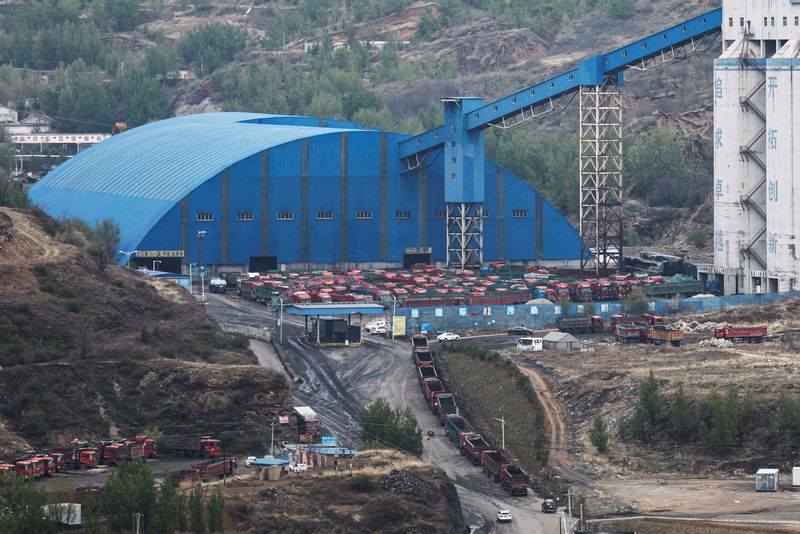By Clyde Russel
LAUNCESTON, Australia (Reuters) – Chinese imports of key raw materials in 2024 were mixed, with record volumes of iron ore, coal and , but weakness in .
Raw data on the world’s largest buyer of natural resources shows that parts of the economy are performing solidly, but others are struggling or undergoing structural shifts.
However, the main challenge in analyzing China’s commodity imports is distinguishing between temporary factors and changes that are part of a long-term trend.
Crude oil is perhaps the best example of this.
Imports for 2024 amounted to 553.42 million tonnes, according to customs data released on Monday. This equates to 11.04 million barrels per day (bpd) and a decline of 2.1%, or 210,000 bpd from 2023.
It is tempting to say that 2024 has shown that the world’s largest importer of crude oil has peaked, and that less oil will arrive in 2025 and beyond.
The main reason for this is the rapid adoption by more than 50% of the market of what China calls New Energy Vehicles (NEVs), a term that groups both fully electric vehicles and hybrids.
While the move to NEVs is impressive and likely to continue at a rapid pace, it’s worth noting that China’s fleet of combustion engine cars is still growing, and that should in theory increase gasoline demand as well.
The picture for diesel is similar in that an alternative is eating away at the market share of the heavy-duty transportation fuel, with trucks powered by liquefied natural gas (LNG).
China’s imports of natural gas, both as LNG and from pipelines, increased by almost 10% to 131.69 million tonnes in 2024.
But perhaps the most important factor driving lower crude imports is price, with benchmark futures remaining above $70 a barrel throughout 2024, apart from two days in September when the price briefly fell below this level.
The stability of crude prices this year reflects the production discipline of the OPEC+ group of exporters, which has effectively cut 5.5 million barrels per day from potential supply.
But it is also likely that Chinese refiners believe that crude oil prices are higher than they should be and have scaled back their purchases accordingly.
IRON ORE, COAL RECORDS
On the other side of weak crude oil imports amid high prices, it seems likely that record imports of iron ore and coal were achieved largely due to lower costs.
Iron ore imports rose 4.9% to 1.236 billion tonnes in 2024, a gain of 57.5 million tonnes.
The price of iron ore contracts traded on the Singapore Exchange (OTC:) peaked early in the year in 2024, reaching $143.60 per tonne on January 3.
They then fell to a low of $91.10 per tonne on September 10, before recovering to end the year at $103.61.
But the 28% decline over the year was likely enough to prompt Chinese steel mills and traders to increase their purchases, especially in the second half of the year when prices were lower than in the first half.
It is also the case that China’s steel mills did not buy more iron ore as they made more steel, with official data showing that crude steel production in the first eleven months of 2024 reached 929.19 million tonnes, down 2.7% from of the same period in 2024. 2023.
Instead, much of the extra iron ore went into stockpiles, with port inventories monitored by consultants SteelHome reaching 146.85 million tonnes last year, up from 114.5 million at the end of 2023.
Coal imports also reached a record high in 2024, reaching 542.7 million tons, up 14.4% from 474.42 million tons in 2023.
Demand for coal rose due to lower hydropower production and increases in electricity demand, but the main impetus for imports was that seaborne prices were competitive with domestic production, allowing utilities, especially in the south of the country, were encouraged to turn to supplies from Indonesia and Australia.
Indonesian coal with an energy content of 4,200 kilocalories per kg was valued at US$49.97 per tonne in the week to December 30 by commodity price reporting agency Argus, down 13.5% for the year and the lowest since April 2021.
SOLID COPPER
There was one key commodity that saw a more stable year in 2024, and that was raw copper imports, which rose a modest 3.3% to 5.68 million tonnes.
Since reaching a record high of 6.68 million tonnes in 2020, Chinese copper imports have remained within a fairly narrow range between 5.5 million and 5.87 million tonnes.
This is perhaps the best indicator of the true state of the Chinese economy, given copper’s essential role in both manufacturing and construction.

Copper imports point to slowing growth momentum in the world’s second-largest economy, as strong sectors such as NEVs and energy transition products such as solar panels are not enough to offset weaker sectors such as residential construction.
The views expressed here are those of the author, a columnist for Reuters.


